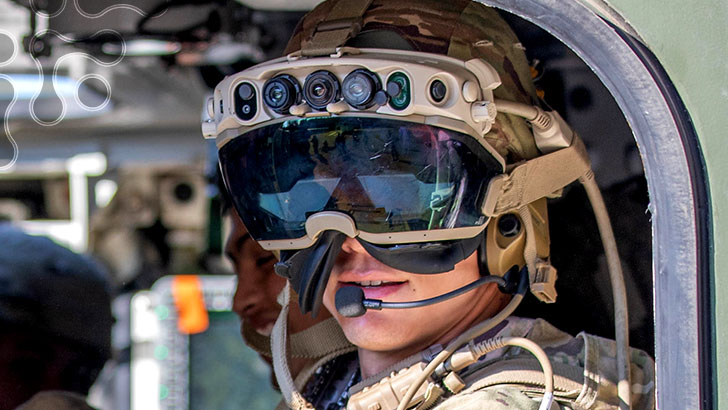

The proposed topic will examine tradeoffs for ground Soldier applications for micro displays, create new backplane architectures, determine optimal Si process nodes and wafer size, and ultimately entail the fabrication and characterization of the micro displays, for further integration into head-mounted display (HMD) systems for augmented reality (AR) outside of this SBIR.
This project will define, build, and characterize micro display technologies (e.g. microLED or OLED) which could eventually be paired with see-through visor optics to build low Size, Weight, and Power, Cost (SWaP-C) Augmented Reality (AR) Heads-up Display (HUD) hardware for the Soldier.
Even though the display and optics technologies have been demonstrated separately, additional SBIR research is needed to minimize power draw during operation while maintaining high brightness that, when combined, ultimately deliver a useful and comfortable Mixed Reality (MR) product for the Soldier. Enabling components will primarily be the trade study to determine high brightness micro display, and the off-the-visor see through optics for displaying the AR content onto.
Vendors can draw on existing fabrication expertise and operational fabrication facilities to lower the entry barrier costs. Additional components like batteries and controls will be required to drive the display with valuable AR content. The basic approach of using micro displays (multi-stack OLEDs, microLEDs, LCD, LCOS, etc.) for high brightness has been demonstrated on other SBIR programs. What is needed from this effort is a micro display optimized for ground Soldier applications that could separately be paired with an optical combiner HUD, and then optimization for AA battery power operation for hours of use.
This topic is only accepting Phase I proposals for a cost up to $250,000 for a 6-month period of performance. The goal is to achieve a micro display with mission capable performance (1000+ line resolution, color, 40+ degree field of view) night or day in a lightweight affordable system which runs several hours on AA batteries. The inherent low-cost nature of this device should make it affordable for wide proliferation among dismounted Soldier units, with an objective target of exceeding the fielding rates of night vision goggles or other heads up displays.
Prototype most ideal micro display, fabricate it, and characterize it in United States Government facility.
Medical device contractors have expressed interest for visor-display systems. Consumer augmented reality also uses micro displays.
For more information, and to submit your full proposal package, visit the DSIP Portal.
SBIR|STTR Help Desk: usarmy.sbirsttr@army.mil

References:
The proposed topic will examine tradeoffs for ground Soldier applications for micro displays, create new backplane architectures, determine optimal Si process nodes and wafer size, and ultimately entail the fabrication and characterization of the micro displays, for further integration into head-mounted display (HMD) systems for augmented reality (AR) outside of this SBIR.
This project will define, build, and characterize micro display technologies (e.g. microLED or OLED) which could eventually be paired with see-through visor optics to build low Size, Weight, and Power, Cost (SWaP-C) Augmented Reality (AR) Heads-up Display (HUD) hardware for the Soldier.
Even though the display and optics technologies have been demonstrated separately, additional SBIR research is needed to minimize power draw during operation while maintaining high brightness that, when combined, ultimately deliver a useful and comfortable Mixed Reality (MR) product for the Soldier. Enabling components will primarily be the trade study to determine high brightness micro display, and the off-the-visor see through optics for displaying the AR content onto.
Vendors can draw on existing fabrication expertise and operational fabrication facilities to lower the entry barrier costs. Additional components like batteries and controls will be required to drive the display with valuable AR content. The basic approach of using micro displays (multi-stack OLEDs, microLEDs, LCD, LCOS, etc.) for high brightness has been demonstrated on other SBIR programs. What is needed from this effort is a micro display optimized for ground Soldier applications that could separately be paired with an optical combiner HUD, and then optimization for AA battery power operation for hours of use.
This topic is only accepting Phase I proposals for a cost up to $250,000 for a 6-month period of performance. The goal is to achieve a micro display with mission capable performance (1000+ line resolution, color, 40+ degree field of view) night or day in a lightweight affordable system which runs several hours on AA batteries. The inherent low-cost nature of this device should make it affordable for wide proliferation among dismounted Soldier units, with an objective target of exceeding the fielding rates of night vision goggles or other heads up displays.
Prototype most ideal micro display, fabricate it, and characterize it in United States Government facility.
Medical device contractors have expressed interest for visor-display systems. Consumer augmented reality also uses micro displays.
For more information, and to submit your full proposal package, visit the DSIP Portal.
SBIR|STTR Help Desk: usarmy.sbirsttr@army.mil
References:
